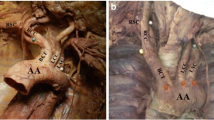Abstract
A bovine arch is the most common aortic arch variant, characterized by a common origin of the innominate artery and the left common carotid artery. Data have shown that children with bovine arch anatomy and coarctation are at a significantly higher risk of recoarctation following coarctation repair. This study aims to explain the higher coarctation rates, assess the branching of the arch vessels, understand their embryologic origins, and delineate the patterns of displacement of the arch vessels in bovine versus normal anatomy. This retrospective study reviewed the medical records of 178 infants ( < 1-year-old) who had a chest CT Angiogram (58) or CT (120) at our institution between 2007 and 2017. Multiplanar reconstruction software was used to obtain the best image plane to display the sinotubular junction, innominate artery, left common carotid artery, and left subclavian artery. We measured the distances between the branches as HV1, HV2, and HV3. All distances were standardized to body surface area and sinotubular junction diameter, which is a novel method. Bovine arches were found in 32.6% of patients. The total arch length of both arch anatomies was similar. HV3 is longer in bovine arches. HV1 + HV2 and HV2 + HV3 are longer in the normal arches than the bovine arches. The left subclavian artery moves proximally, and the innominate artery moves slightly distally to form the bovine arch and decreasing the clamping distance for coarctation repair. Aortic arch distances were similar when standardized to either sinotubular junction diameter and body surface area.




Similar content being viewed by others
References
Turek JW, Conway BD, Cavanaugh NB et al (2018) Bovine arch anatomy influences re-coarctation rates in the era of the extended end-to-end anastomosis. J Thorac Cardiovasc Surg 155(3):1178–1183. https://doi.org/10.1016/j.jtcvs.2017.10.055
Spacek M, Veselka J (2012) Bovine arch. Arch Med Sci 8(1):166–167. https://doi.org/10.5114/aoms.2012.27297
Mcelhinney DB, Yang S, Hogarty AN et al (2001) Recurrent arch obstruction after repair of isolated coarctation of the aorta in neonates and young infants: Is low weight a risk factor? J Thorac Cardiovasc Surg 122(5):883–890. https://doi.org/10.1067/mtc.2001.116316
Son JA, Falk V, Schneider P, Smedts F, Mohr FW (1997) Repair of coarctation of the aorta in neonates and young infants. J Card Surg 12:139–146. https://doi.org/10.1111/j.1540-8191.1997.tb00114.x
Jakanani G, Adair W (2010) Frequency of variations in aortic arch anatomy depicted on multidetector CT. Clin Radiol 65(6):481–487. https://doi.org/10.1016/j.crad.2010.02.003
Rea G, Valente T, Iaselli F et al (2015) Multi-detector computed tomography in the evaluation of variants and anomalies of aortic arch and its branching pattern. Ital J Anat Embryol 119(3):180–192. https://doi.org/10.13128/IJAE-15541
Celikyay ZR, Koner AE, Celikyay F, Denız C, Acu B, Firat MM (2013) Frequency and imaging findings of variations in human aortic arch anatomy based on multidetector computed tomography data. Clin Imaging 37(6):1011–1019. https://doi.org/10.1016/j.clinimag.2013.07.008
Berko NS, Jain VR, Godelman A, Stein EG, Ghosh S, Haramati LB (2009) Variants and anomalies of thoracic vasculature on computed tomographic angiography in adults. J Comput Assist Tomogr 33(4):523–528. https://doi.org/10.1097/RCT.0b013e3181888343
Arnáiz-García ME, González-Santos JM, López-Rodriguez J et al (2014) A bovine aortic arch in humans. Indian Heart J 66(3):390–391. https://doi.org/10.1016/j.ihj.2014.03.021
Endean ED (2019) Embryology and developmental anatomy. In: Rutherford's vascular surgery and endovascular therapy, 9th edn. Elsevier, Philadelphia, pp 13–29
Kau T, Sinzig M, Gasser J et al (2007) Aortic development and anomalies. Semin Interv Radiol 24(2):141–152. https://doi.org/10.1055/s-2007-980040
Funding
This research received no specific grant from any funding agency, commercial or not-for-profit sectors.
Author information
Authors and Affiliations
Corresponding author
Ethics declarations
Conflicts of interest
The authors declare that they have no competing interests.
Additional information
Publisher's Note
Springer Nature remains neutral with regard to jurisdictional claims in published maps and institutional affiliations.
Rights and permissions
About this article
Cite this article
Meyer, A.M., Turek, J.W., Froud, J. et al. Insights into Arch Vessel Development in the Bovine Aortic Arch. Pediatr Cardiol 40, 1445–1449 (2019). https://doi.org/10.1007/s00246-019-02156-6
Received:
Accepted:
Published:
Issue Date:
DOI: https://doi.org/10.1007/s00246-019-02156-6




